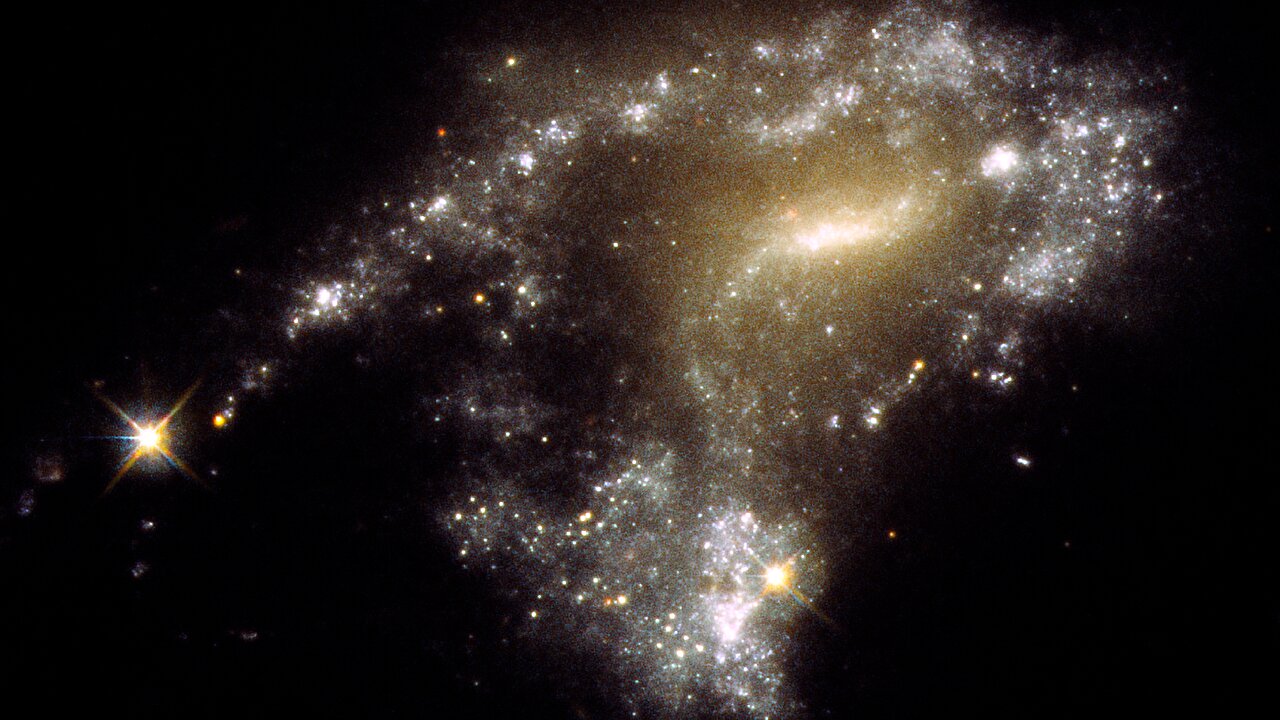
Galaxy AM 1054-325 has been distorted into an S shape from a regular, pancake-like spiral due to the gravitational pull of a nearby galaxy, as seen in this image taken by the Hubble Space Telescope. As a result, clusters of newborn stars form along a tidal tail extending thousands of light-years, resembling a string of pearls. They form when clusters of gas collapse under gravity to form about a million newborn stars in each cluster. Image source: NASA, ESA, STScI, Jayanne English (University of Manitoba)
× Close
Galaxy AM 1054-325 has been distorted into an S shape from a regular, pancake-like spiral due to the gravitational pull of a nearby galaxy, as seen in this image taken by the Hubble Space Telescope. As a result, clusters of newborn stars form along a tidal tail extending thousands of light-years, resembling a string of pearls. They form when clusters of gas collapse under gravity to form about a million newborn stars in each cluster. Image source: NASA, ESA, STScI, Jayanne English (University of Manitoba)
When amazing cosmic events such as galaxy collisions occur, they trigger interactions to form new stars and perhaps new planets that would not have formed otherwise. The force of gravity that forces collisions between these galaxies creates tidal tails — a long, thin region of stars and interstellar gas.
The Hubble Space Telescope's vision is so sharp that it can see clusters of newborn stars suspended along the tidal tails. They form when clusters of gas collapse under gravity to form about a million newborn stars in each cluster.
Specifically, NASA's Hubble Space Telescope focused on 12 interacting galaxies that have long, tadpole-like tidal tails made up of gas, dust, and a large population of stars. Hubble's remarkable resolution and ultraviolet sensitivity have revealed 425 clusters of newborn stars along these tails, which look like strings of holiday lights.
Each cluster contains up to a million blue newborn stars.
Populations in the tidal tails have been known for decades. When galaxies interact, gravitational tidal forces pull in long streams of gas and dust. Two common examples are the antennae and mice with their long, narrow, finger-like projections.
In a study recently published in Monthly Notices of the Royal Astronomical Society Astronomers used the near-infrared capabilities of NASA's Hubble Space Telescope to study tidal tail clusters and determine their ages and masses, along with the properties of merging galaxies.
Michael Rudrak of Randolph-Macon College is the lead author of this study with co-authors including ASU scientists Sanchaita Borthakur and Karen Knerman of the School of Earth and Space Exploration.
A team of astronomers used a combination of new observations and archival data to obtain the ages and masses of tidal star clusters. They found that these clusters are very young, only 10 million years old. They appear to form at the same rate along tails extending thousands of light-years.
“These observations tell us how stars form and what regulates those processes,” said Assistant Professor Sanchaita Borthakur, an observational astronomer specializing in extragalactic astronomy at Arizona State University’s Earth College. “This knowledge is essential to understanding how stars form in our galaxy.” and space exploration.
The tails appear to take the galactic spiral arm and extend it out into space. The outer part of the arm is pulled like candy from a gravitational tug of war between a pair of interacting galaxies.
Before the mergers, galaxies were rich in dust clouds of molecular hydrogen, which may have remained inert. But the clouds crowded together and collided with each other during the encounters. This compressed the hydrogen to the point that it triggered a firestorm of star birth.
The fate of these suspended star clusters is uncertain. They may remain gravitationally intact and evolve into spherical star clusters, such as those orbiting outside the plane of our Milky Way Galaxy. Or they may scatter to form a halo of stars around their host galaxy, or be jettisoned to become intergalactic wandering stars.
“It is very exciting to present the culmination of more than two decades of work on star clusters in tidal tails using data from different eras of Hubble combined with those from other telescopes,” said Assistant Professor Karen Knirman. “I started working on this project when I was an undergraduate at Penn State in 1999, and some of the same data and results are used here. We obtained additional data from the Hubble program in which I was the (principal investigator) when I came to ASU in 2007.” “.
String-of-pearl star formation may have been more common in the early universe when galaxies frequently collided with each other. These nearby galaxies observed by Hubble are an indicator of what happened a long time ago, and thus allow us to look into the distant past.
“It's a surprise to see so many small objects in the tails,” Rudrak said. “This tells us a lot about the efficiency of mass formation.” “Using tidal tails, you will build new generations of stars that might not have otherwise existed.”
more information:
Michael Rudrak et al., Stellar clusters in tidal debris, Monthly Notices of the Royal Astronomical Society (2023). doi: 10.1093/manras/stad2886 , academy.oup.com/mnras/article/526/2/2341/7286662
Magazine information:
Monthly Notices of the Royal Astronomical Society

“Web maven. Infuriatingly humble beer geek. Bacon fanatic. Typical creator. Music expert.”





More Stories
Scientists confirm that monkeys do not have time to write Shakespeare: ScienceAlert
SpaceX launches 23 Starlink satellites from Florida (video and photos)
A new 3D map reveals strange, glowing filaments surrounding the supernova